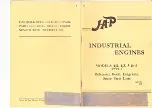
G420E/G424E
Tier
LP Engine
System Operational Overview
25
MI-04 SECM
(General Description)
The Woodward Small Engine Control Module (SECM)
controller has full authority over spark, fuel and air.
Utilizing Motorola’s HCS12 micro controller, the
SECM has 24 pins of I/O and is fully waterproof and
shock hardened (Figure 23).
To optimize engine
performance and drivability, the SECM uses several
sensors for closed loop feedback information.
These sensors are used by the SECM for closed loop
control in three main categories:
z
Fuel Management
z
Load/Speed Management
z
Ignition Management
The SECM monitors system parameters and stores
any out of range conditions or malfunctions as faults
in SECM memory. Engine run hours are also stored
in memory. Stored fault codes can be displayed on
the Malfunction Indicator Light (MIL) as flash codes or
read by the MI-04 Service Tool software through a
CAN (Controller Area Network) communication link.
Battery power (12 VDC) is supplied through the fuse
block to the main power relay. The ignition key switch
is used to energize the main power relay. A main
power relay supplies 12 VDC power to the SECM, the
heated element of the oxygen sensor, Fuel Lock-Off,
Fuel Trim Valve (FTV) and the Smart Coil. The SECM
supplies positive voltage to the electronic throttle
actuator, oil pressure switch and the coolant
temperature sensor. Transducer or sensor power (+5
VDC) is regulated by the SECM and supplied to the
Temperature/Manifold Air Pressure Sensor (TMAP),
Throttle Position Sensor (TPS), and the Accelerator
Pedal Position Sensors (APP1 & APP2). The SECM
provides a constant voltage (VCC) to the Smart Coil
Driver, transducer ground for the all sensors, and a
low side driver signal controlling the fuel lock-off, MIL
and FTV.
MI-04 SECM
(Fuel Management)
During engine cranking at startup, the SECM
provides a low side driver signal to the fuel lock-off,
which opens the lock-off allowing liquid propane to
flow to the N2001 regulator. A stall safety shutoff
feature is built into the SECM to close the lock-off in
case of a stall condition. The SECM monitors three
engine states. Crank, when the VR sensor detects
any engine revolutions. Stall, when the key is in the
ON position but the VR sensor detects no engine
revolutions, and the Run state, when the engine
reaches pre-idle RPM. When an operator turns on the
key switch the lock-off is opened but if the operator
fails to crank the engine, the SECM will close the
lock-off after 5 seconds.
To maintain proper exhaust emission levels, the
SECM uses a heated exhaust gas oxygen sensor
(HEGO) mounted before the catalyst, to measure
exhaust gas content in the LP gas system. Engine
speed is monitored by the SECM through a variable
reluctance (VR) sensor.
Intake manifold air
temperature and absolute pressure is monitored with
a (TMAP) sensor. The HEGO voltage is converted to
an air fuel ratio value. This value is then compared to
a target value in the SECM. The target value is based
on optimizing catalyst efficiency for a given load and
speed. The SECM then calculates any corrections
that need to be made to the air fuel ratio.
The system operates in open loop fuel control until
the engine has done a certain amount of work. This
ensures that the engine and HEGO are sufficiently
warmed up to stay in control. In open loop control, the
FTV duty cycle is based on engine speed and load.
Once the HEGO reaches operating temperature the
fuel management is in closed loop control for all
steady state conditions, from idle through full throttle.
In closed loop mode, the FTV duty cycle is based on
feedback from the HEGO sensor. In order to handle
transient loads, engine RPM and load is compared to
a threshold used by the SECM. When this threshold
is exceeded, the FTV duty cycle will be set to a Feed
Forward Adaptive value.
The SECM then makes any necessary corrections to
the air fuel ratio by controlling the inlet fuel pressure
to the air/fuel mixer Reducing the fuel pressure leans
the air/fuel mixture and increasing the fuel pressure
enriches the air/fuel mixture. Control is achieved by
modulating the fuel trim
SECM
Figure 23
















































